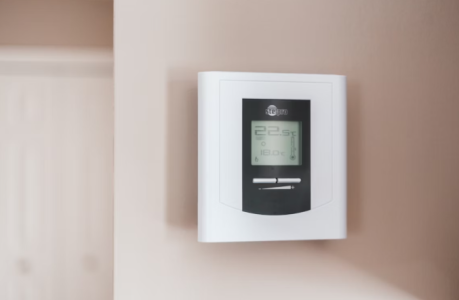How one thermostat setting can lower bills and stop mold in its tracks
- Replies 0
Americans facing rising electricity costs are being urged to make only a minor thermostat adjustment that could save money while protecting their homes.
Energy bills have surged to the highest level in more than a decade, leaving many households searching for practical ways to reduce costs.
Experts say the right temperature range can also help prevent condensation and mold, which can quickly become a costly issue. With both comfort and savings in mind, the advice is straightforward and easy to follow.
The US Department of Energy recommends keeping the thermostat no more than seven to ten degrees off a normal setting for about eight hours daily.
By doing so, households can save at least 10% annually on energy, which translates to nearly $180 for the average bill of $1,788.
Savings vary depending on climate, with residents in harsher regions needing to adjust their usage carefully.
The department also notes that “the smaller the difference between the indoor and outdoor temperatures, the lower your overall cooling bill will be.”

During the winter months, experts suggest keeping the thermostat between 68 and 70 degrees while awake and lowering it slightly when asleep or away.
In the summer, the recommended range is 74 to 76 degrees at home, with higher settings when the house is empty.
HVAC specialist Bill Taylor noted that “bumping your thermostat even 1-2 degrees can reduce cooling costs by up to 3-5%.”
He warned that completely shutting off systems risks mold growth and adds strain that may shorten the lifespan of the unit.
Patrick Phelan, a professor of mechanical engineering at Arizona State University, explained that a one-degree increase could deliver about 3% monthly savings on cooling costs.
However, he emphasized the importance of keeping the system running to manage indoor humidity and avoid damage.
Elizabeth Hewitt, a professor at Stony Brook University, recommended investing in smart thermostats that can automatically adjust based on occupancy.
“If you're going from just an ordinary thermostat to installing a smart one like Nest, then you can expect something like 10% savings,” she said.
Electricity prices have risen by 5.5% compared to last year, according to the Bureau of Labor Statistics, making cost-saving adjustments more important than ever.
Experts agree that keeping temperatures stable while making minor changes at strategic times is the most effective approach.
With households balancing high bills and concerns about mold or maintenance issues, these simple thermostat practices could be a practical solution. Even small changes today may deliver noticeable savings over the course of a year.
Read next:

Would you be willing to raise or lower your thermostat slightly if it meant cutting your yearly energy bills by more than $100? Share your thoughts in the comments and let us know if you’ve already tried these methods or invested in a smart thermostat to see the difference for yourself.
Energy bills have surged to the highest level in more than a decade, leaving many households searching for practical ways to reduce costs.
Experts say the right temperature range can also help prevent condensation and mold, which can quickly become a costly issue. With both comfort and savings in mind, the advice is straightforward and easy to follow.
The US Department of Energy recommends keeping the thermostat no more than seven to ten degrees off a normal setting for about eight hours daily.
By doing so, households can save at least 10% annually on energy, which translates to nearly $180 for the average bill of $1,788.
Savings vary depending on climate, with residents in harsher regions needing to adjust their usage carefully.
The department also notes that “the smaller the difference between the indoor and outdoor temperatures, the lower your overall cooling bill will be.”

How one thermostat setting can lower bills and stop mold in its tracks. Image source: Erik Mclean / Unsplash
During the winter months, experts suggest keeping the thermostat between 68 and 70 degrees while awake and lowering it slightly when asleep or away.
In the summer, the recommended range is 74 to 76 degrees at home, with higher settings when the house is empty.
HVAC specialist Bill Taylor noted that “bumping your thermostat even 1-2 degrees can reduce cooling costs by up to 3-5%.”
He warned that completely shutting off systems risks mold growth and adds strain that may shorten the lifespan of the unit.
Patrick Phelan, a professor of mechanical engineering at Arizona State University, explained that a one-degree increase could deliver about 3% monthly savings on cooling costs.
However, he emphasized the importance of keeping the system running to manage indoor humidity and avoid damage.
Elizabeth Hewitt, a professor at Stony Brook University, recommended investing in smart thermostats that can automatically adjust based on occupancy.
“If you're going from just an ordinary thermostat to installing a smart one like Nest, then you can expect something like 10% savings,” she said.
Electricity prices have risen by 5.5% compared to last year, according to the Bureau of Labor Statistics, making cost-saving adjustments more important than ever.
Experts agree that keeping temperatures stable while making minor changes at strategic times is the most effective approach.
With households balancing high bills and concerns about mold or maintenance issues, these simple thermostat practices could be a practical solution. Even small changes today may deliver noticeable savings over the course of a year.
Read next:
- Are you making these home repair mistakes that could be draining your wallet?
- Unlock the perfect thermostat setting to lower your heating bills!
Key Takeaways
- A slight thermostat adjustment can save households around 10% on annual energy bills, according to the US Department of Energy.
- Winter settings are advised at 68 to 70 degrees while awake, with summer ranges suggested between 74 and 76 degrees.
- Experts caution against turning systems completely off, as it can lead to mold growth and expensive equipment strain.
- Smart thermostats can add further savings, automatically adjusting to occupancy and potentially cutting costs by an additional 10%.






